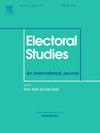Wrong place or wrong party? LGBTQ2S+ candidates and district competitiveness
IF 2.3
2区 社会学
Q1 POLITICAL SCIENCE
引用次数: 0
Abstract
The sacrificial lambs thesis holds that internal processes lead parties to nominate candidates from marginalized groups in unwinnable districts. This thesis was first developed to explain women's underrepresentation, but it has since been applied to other groups. The case of LGBTQ2S+ candidates presents an opportunity to explore whether the distribution of candidates across parties can account for (some of) the sacrificial lambs pattern. Are LGBTQ2S+ candidates sacrificial lambs because they run in less winnable districts than their straight cisgender (cis) counterparts or because less competitive third parties are more likely to nominate them? We reconceptualize the sacrificial lambs pattern as a gap in district competitiveness. Conceptually, we see this gap as having two components: a within-party component (from differences in where parties nominate members of a marginalized group) and a between-party component (from differences in which parties nominate more members of a marginalized group). We illustrate how to decompose the gap using data on LGBTQ2S+ candidates in Canadian elections, 2015–2021. We construct probability-based measures of district competitiveness and then use Kitigawa-Blinder-Oaxaca decomposition to calculate the within- and between-party components. We find large gaps in district competitiveness in 2019 and 2021, the majority of which is attributable to between-party inequalities. Nonetheless, a substantial portion of this inequality reflects within-party inequalities. Our results suggest that efforts to improve LGBTQ2S+ representation will need to address between-party inequalities in addition to the more traditional focus on within-party inequalities. Our approach could be used to study other groups in other contexts.
地点错了还是派对错了?LGBTQ2S+候选人与地区竞争力
“牺牲羔羊论”认为,内部程序导致各政党从无望获胜的地区的边缘群体中提名候选人。这一理论最初是用来解释女性代表性不足的,但后来被应用于其他群体。LGBTQ2S+候选人的案例提供了一个机会,可以探讨候选人在各党派之间的分布是否可以解释(部分)牺牲羔羊模式。LGBTQ2S+候选人是否因为他们在比他们的异性恋(cis)对手更不容易获胜的地区竞选,或者因为竞争力较弱的第三方更有可能提名他们而成为牺牲品?我们将牺牲羔羊模式重新定义为地区竞争力的差距。从概念上讲,我们认为这种差距有两个组成部分:政党内部组成部分(来自政党提名边缘群体成员的差异)和政党之间的组成部分(来自政党提名更多边缘群体成员的差异)。我们使用2015-2021年加拿大选举中LGBTQ2S+候选人的数据来说明如何分解这一差距。我们构建了基于概率的地区竞争力度量,然后使用Kitigawa-Blinder-Oaxaca分解来计算党派内部和党派之间的成分。我们发现,2019年和2021年的地区竞争力差距很大,其中大部分归因于政党之间的不平等。尽管如此,这种不平等在很大程度上反映了党内的不平等。我们的研究结果表明,除了传统的关注党内不平等之外,改善LGBTQ2S+代表性的努力还需要解决党与党之间的不平等问题。我们的方法可以用于研究其他背景下的其他群体。
本文章由计算机程序翻译,如有差异,请以英文原文为准。
求助全文
约1分钟内获得全文
求助全文
来源期刊

Electoral Studies
POLITICAL SCIENCE-
CiteScore
3.40
自引率
13.00%
发文量
82
审稿时长
67 days
期刊介绍:
Electoral Studies is an international journal covering all aspects of voting, the central act in the democratic process. Political scientists, economists, sociologists, game theorists, geographers, contemporary historians and lawyers have common, and overlapping, interests in what causes voters to act as they do, and the consequences. Electoral Studies provides a forum for these diverse approaches. It publishes fully refereed papers, both theoretical and empirical, on such topics as relationships between votes and seats, and between election outcomes and politicians reactions; historical, sociological, or geographical correlates of voting behaviour; rational choice analysis of political acts, and critiques of such analyses.
 求助内容:
求助内容: 应助结果提醒方式:
应助结果提醒方式:


